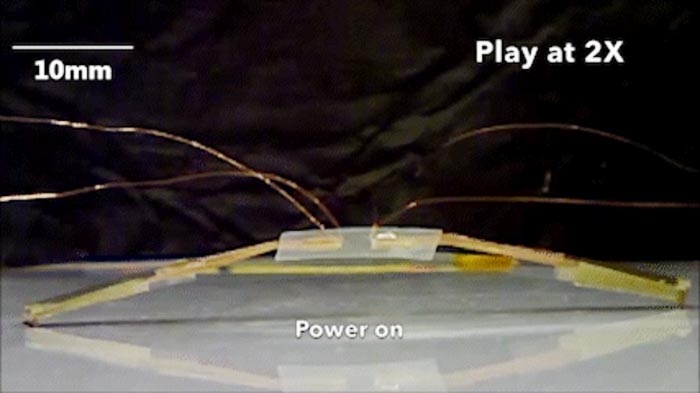Robot “bugs” that can go just about anywhere

The bug-inspired robot designed by M. Ravi Shankar's Lab.
Credit: The Shankar Research Group
Pitt engineers create insect-inspired robots that can monitor hard-to-reach spots.
These ancient creatures can squeeze through the tiniest cracks, fit snugly into tight spaces and survive in harsh environments: There aren’t many spaces that are off-limits to an insect.
That’s why researchers at the University of Pittsburgh have created tiny bug-inspired robots that can carry out tasks in hard-to-reach spaces and inhospitable environments.
“These robots could be used to access confined areas for imaging or environmental evaluation, take water samples, or perform structural evaluations,” said Junfeng Gao, who led the work as a PhD student in industrial engineering at the Swanson School of Engineering. “Anywhere you want to access confined places—where a bug could go but a person could not—these machines could be useful.”
For many creatures under a certain size—like trap-jaw ants, mantis shrimp, and fleas—jumping across a surface is more energy-efficient than crawling. Those impulsive movements were replicated in the robots, which are made of a polymeric artificial muscle.
“It’s akin to loading an arrow into a bow and shooting it—the robots latch on to build up energy and then release it in an impulsive burst to spring forward,” explained M. Ravi Shankar, professor of industrial engineering at Pitt whose lab led the research. “Usually, actuation in the artificial muscles we work with is fairly slow. We were drawn to the question, ‘How do we take this artificial muscle and use it to generate a jumping actuation rather than slow actuation?’”
The answer lay in the interplay of molecular order and geometry.
“The curved composite shape of the polymer muscle allows it to build energy when it is powered. The way the molecules are aligned in the muscle draws inspiration from the natural world, where their combined actuation builds energy into the structure,” said Mohsen Tabrizi, co-author of the study and PhD student in industrial engineering at the Swanson School. “This is accomplished using no more than a few volts of electricity.”
The versatile movement and lightweight structure enables the robots—which are about the size of a cricket—to move along moving surfaces like sand as easily as hard surfaces, and even to hop across water.
The paper, “Molecularly Directed, Geometrically Latched, Impulsive Actuation Powers Sub-Gram Scale Motility,” (DOI: 10.1002/admt.202100979) was published in the journal Advanced Materials Technologies and was coauthored by Junfeng Gao, Arul Clement, Mohsen Tabrizi, and M. Ravi Shankar.
Journal: Advanced Materials Technologies
DOI: 10.1002/admt.202100979
Article Title: Molecularly directed, geometrically latched, impulsive actuation powers sub-gram scale motility
Media Contact
Maggie Lindenberg
University of Pittsburgh
mlindenberg@pitt.edu
All latest news from the category: Materials Sciences
Materials management deals with the research, development, manufacturing and processing of raw and industrial materials. Key aspects here are biological and medical issues, which play an increasingly important role in this field.
innovations-report offers in-depth articles related to the development and application of materials and the structure and properties of new materials.
Newest articles

Innovative 3D printed scaffolds offer new hope for bone healing
Researchers at the Institute for Bioengineering of Catalonia have developed novel 3D printed PLA-CaP scaffolds that promote blood vessel formation, ensuring better healing and regeneration of bone tissue. Bone is…

The surprising role of gut infection in Alzheimer’s disease
ASU- and Banner Alzheimer’s Institute-led study implicates link between a common virus and the disease, which travels from the gut to the brain and may be a target for antiviral…

Molecular gardening: New enzymes discovered for protein modification pruning
How deubiquitinases USP53 and USP54 cleave long polyubiquitin chains and how the former is linked to liver disease in children. Deubiquitinases (DUBs) are enzymes used by cells to trim protein…



